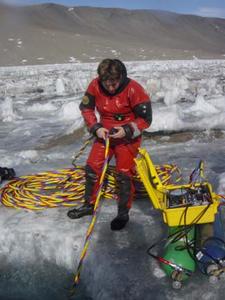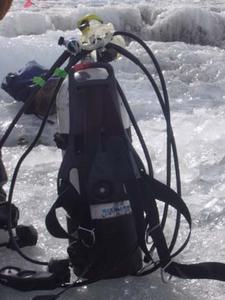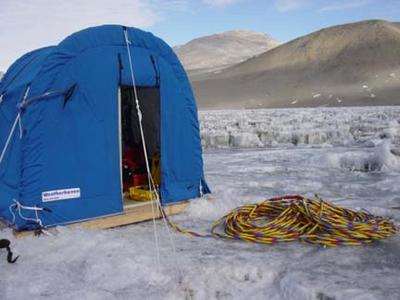16 November, 2004
Light levels and support from town!
Temperature: 17*F
Location: Lake Hoare
Not too long ago, I had a ďlive chatĒ over the internet with my school in NH and
anyone who was listening in during the broadcast. During this chat, we
discussed how important the support teams are to the scientists here in
Antarctica. It truly would be very difficult for most of this research to be
done without the never ending support in McMurdo. There are mechanics to fix
engines, computer specialists to tackle computer glitches, welders, doctors,
chefs, builders, and pilots just to name a few. Itís not that the science
could not get done without the support, itís just that it would be infinitely
more difficult.
Yesterday, we had a dive compressor delivered from town so that we can refill
our dive tanks. While we were refilling the tanks, we noticed a significant
air leak from the machine. We were pumping almost as much air back out into
the environment as we were putting into our tanks! We located the source of
the leak and attempted to first stop the leak by tightening the bolt.
Unfortunately, this decision caused the bolt to be sheered right off the
machine. Without a working compressor, no diving could get done. We had
enough air left in the tanks to last for three dives; depending on depth and
longevity. The tanks we pull our air from for surface supply diving are huge
cylinders, not regular sized dive tanks. We called the Mechanical Equipment
Center, or MEC, back in McMurdo and asked for assistance.
We took digital pictures of the problem and emerald the photos to the MEC
building. Within a few hours, they had a mechanic on a helicopter coming to
help. Luckily for us, the problem was easily remedied and we got back to
diving!
During my dive today, I took light level measurements of the water column below
Lake Hoare. I took a light meter which was attached to a super long cable down
under the ice with me. Once under the ice, I swam straight out from the dive
hole taking measurements every 10 meters. In designated areas, I also
descended to the bottom, taking light measurements every 7-10 feet. The lake,
in the area where we were sampling, is only about 50 feet deep. I quite
enjoyed being part of the actual data collection.
Ian then dove and collected sediment samples to analyze in the lab. Ian is
interested in the photosynthetic levels of the cyanobacteria that live in these
lakes. Photosynthetic organisms need light in order to photosynthesize. Ian
and Kay then took the collected samples and the known light measurement values
back to the lab.

1. Me tending the dive line for Ian; I am talking to him on the handset as he dives!

2. Dive tank for the back up diver; notice there are two regulators attached.

3. The "polar haven" is our dive hut on the ice. A considerable amount of our gear and the compressor are stored in this hut. It's also a place to get in out of the wind and cold.

4. A close up view of the air intake valve. The hose is connected to the compressor which forces air from the environment into our storage air tanks.

5. The "dive box." The white outlined square on the top left includes the communications cables, the power switches, and the speaker. This allows us to communicate from below ice to the surface and vice versa. The bottom left contains the hoses that go to the tanks; the knobs allow the amount of air coming out of the tanks to be controlled. The bottom right is the guage indicating the air pressure the diver is breathing through. The top right is the neumo guage which allows us to spot check the depth of the diver.

6. The dive compressor. The pointed end of the axe is resting on the broken part.

7. The broken part!

8. Back in the lab, Ian zaps the algal matt with an electrode to measure photosynthesis.
Contact the TEA in the field at
.
If you cannot connect through your browser, copy the
TEA's e-mail address in the "To:" line of
your favorite e-mail package.
|
